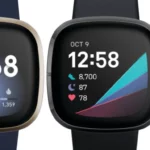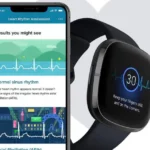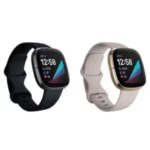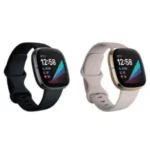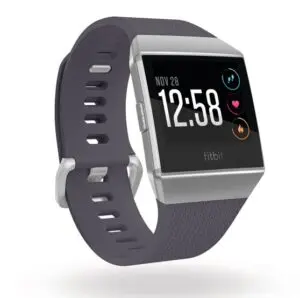
Fitbit Ionic User Manual
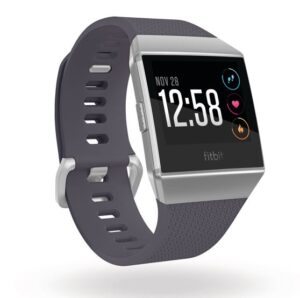
User Manual Version 4.3
Get started
Welcome to Fitbit Ionic, the watch designed for your life. Find the guidance to
reach your goals with dynamic workouts, on-board GPS, and continuous heart rate
tracking. Take a moment to review our complete safety information at
http://www.fitbit.com/safety.
What’s in the box
Your Ionic box includes:
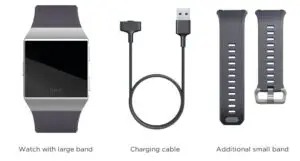
The detachable bands on Ionic come in a variety of colors and materials, sold
separately.
Set up Ionic
For the best experience, use the Fitbit app for iPhones and iPads or Android
phones. You can also set up Ionic on Windows 10 devices. If you don’t have a
compatible phone or tablet, use a Bluetooth-enabled Windows 10 PC. Keep in mind that a phone is required for call, text, calendar, and smartphone app notifications.
To create a Fitbit account, you’re prompted to enter your birthdate, height, weight,
and sex to calculate your stride length and to estimate distance, basal metabolic
rate, and calorie burn. After you set up your account, your first name, last initial, and profile picture are visible to all other Fitbit users. You have the option to share other information, but most of the information you provide to create an account is private by default.
Charge your watch
A fully-charged Ionic has a battery life of up to 5 days. Battery life and charge
cycles vary with use and other factors; actual results will vary.
To charge Ionic:
- Plug the charging cable into the USB port on your computer, a UL-certified
USB wall charger, or another low-energy charging device. - Hold the other end of the charging cable near the port on the back of the
watch until it attaches magnetically. Make sure the pins on the charging cable
align with the port on the back of your watch.

Charging fully takes up to 2 hours. While the watch charges, you can tap the screen
or press any button to check the battery level.
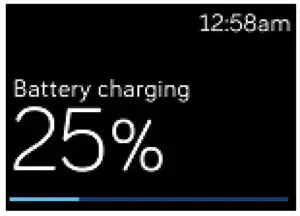
Set up with your phone or tablet
Set up Ionic with the Fitbit app. The Fitbit app is compatible with most popular
phones and tablets. For more information, see fitbit.com/devices.
To get started:
- Download the Fitbit app: -Apple App Store for iPhones and iPads -Google Play Store for Android phones -Microsoft Store for Windows 10 devices
- Install the app, and open it. -If you already have a Fitbit account, log in to your account > tap the Today tab > your profile picture > Set Up a Device. -If you don’t have a Fitbit account, tap Join Fitbit to be guided through a
series of questions to create a Fitbit account. - Continue to follow the on-screen instructions to connect Ionic to your account.
When you’re done with setup, read through the guide to learn more about your
new watch and then explore the Fitbit app.
For more information, see help.fitbit.com
Set up with your Windows 10 PC
If you don’t have a compatible phone, you can set up and sync Ionic with a
Bluetooth-enabled Windows 10 PC and the Fitbit app.
To get the Fitbit app for your computer:
- Click the Start button on your PC and open the Microsoft Store.
- Search for “Fitbit app”. After you find it, click Free to download the app to
your computer. - Click Microsoft account to sign in with your existing Microsoft account. If you
don’t already have an account with Microsoft, follow the on-screen instructions to create a new account. - Open the app.
-If you already have a Fitbit account, log in to your account, and tap the
account icon > Set Up a Device.
-If you don’t have a Fitbit account, tap Join Fitbit to be guided through a
series of questions to create a Fitbit account. - Continue to follow the on-screen instructions to connect Ionic to your account.
When you’re done with setup, read through the guide to learn more about your
new watch and then explore the Fitbit app.
Connect to Wi-Fi
During setup, you’re prompted to connect Ionic to your Wi-Fi network. Ionic uses
Wi-Fi to more quickly download playlists and apps from the Fitbit App Gallery, and for faster, more reliable OS updates.
Ionic can connect to open, WEP, WPA personal, and WPA2 personal Wi-Fi
networks. Your watch won’t connect to 5GHz, WPA enterprise, or public Wi-Fi
networks that require more than a password to connect—for example, logins,
subscriptions, or profiles.
If you see fields for a username or domain when connecting to the Wi-Fi network on a computer, the network isn’t supported. For best results, connect Ionic to your home Wi-Fi network. Make sure you know the network password before connecting.
For more information, see help.fitbit.com
See your data in the Fitbit app
Sync Ionic to transfer your data to the Fitbit app, where you can view your activity
and sleep data, log food and water, participate in challenges, and more.
Wear Ionic
Place Ionic around your wrist. If you need to attach a different size band, or if you
purchased another band, see the instructions in “Change the band” on page 13.
Placement for all-day wear vs. exercise
When you’re not exercising, wear Ionic a finger’s width above your wrist bone.
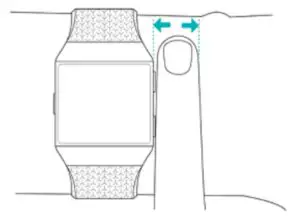
For optimized heart-rate tracking while exercising:
- During a workout, experiment with wearing your watch a bit higher on your
wrist for an improved fit. Many exercises, such as bike riding or weight lifting,
cause you to bend your wrist frequently, which could interfere with the heartrate signal if the watch is lower on your wrist. - Wear your watch on top of your wrist, and make sure the back of the device is
in contact with your skin. - Consider tightening your band before a workout and loosening it when you’re
done. The band should be snug but not constricting (a tight band restricts
blood flow, potentially affecting the heart-rate signal).
Handedness
For greater accuracy, you must specify whether you wear Ionic on your dominant or
non-dominant hand. Your dominant hand is the one you use for writing and eating.
To start, the Wrist setting is set to non-dominant. If you wear Ionic on your
dominant hand, change the Wrist setting in the Fitbit app:
From the Today tab in the Fitbit app, tap your profile picture > Ionic tile > Wrist
> Dominant.
Change the band
Ionic comes with a large band attached and an additional small band in the box. The band has two separate bands (top and bottom) that you can swap with accessory bands, sold separately. For band measurements, see “Band size” on page 63.
Remove a band
- Turn over Ionic and find the band latches.
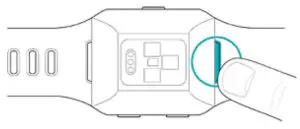
- To release the latch, press down on the flat metal button on the strap.
- Gently pull the band away from the watch to release it.
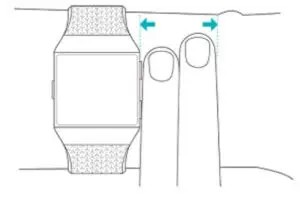
- Repeat on the other side.
If you’re having trouble removing the band or if it feels stuck, gently move the band
back and forth to release it.
Attach a band
To attach a band, press it into the end of the watch until you feel it snap into place.
The band with the clasp attaches to the top of the watch.
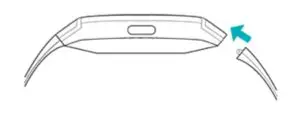
Basics
Learn how to manage Ionic’s settings, set a personal PIN code, navigate the screen,
and more.
Navigate Ionic
Ionic has a touch screen with a colored LCD and three buttons: back, top, and
bottom.

Navigate Ionic by tapping the screen, swiping side-to-side and up and down, or
pressing the buttons. To preserve battery, Ionic’s screen turns off when not in use.
To turn it on, double-tap the screen or press any button.
Basic navigation
The home screen is the clock.
- Swipe down from the top of the screen to see notifications and access the
shortcuts to music controls, Fitbit Pay, and quick settings. The shortcuts
disappear after 2 seconds. Swipe down to see them again. - Swipe up to see your daily stats.
- Swipe left to see the apps on your watch.
- Press the back button to go back to a previous screen or return to the clock
face.

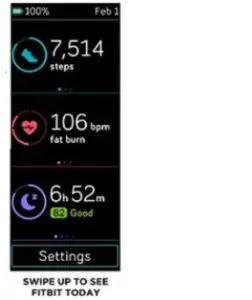
Button shortcuts
Press and hold the buttons on Ionic for a faster way to access certain features, see
notifications, and open apps.
Choose a shortcut
Hold the back button for 2 seconds to activate Fitbit Pay, music controls,
notifications, or certain apps.
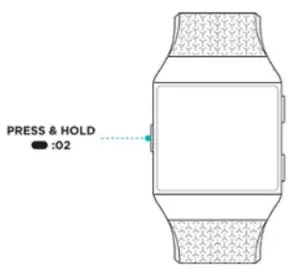
The first time you use the button shortcut, you select which feature it activates. To
later change which feature activates when you hold the button, open the Settings
app on your watch and tap the Left Button option.
Notifications
To see your notifications, press and hold the top button:
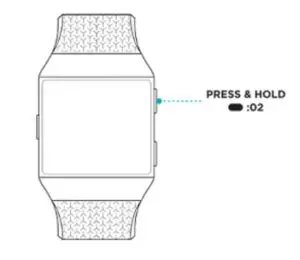
Swipe up or down to scroll through your notifications.
App shortcuts
Press the buttons on Ionic for quick access to your favorite apps. To access these
shortcuts, navigate to the clock screen. The buttons are mapped as follows:
- Top button–opens the app located in the top left of the first app screen.
- Bottom button–opens the app located in the bottom left of the first app
screen.
Customize Ionic by reordering your apps. For more information, see “Organize
apps” on page 23.
Quick settings
Swipe down from the top of your watch screen, and tap the quick settings icon
to access certain settings.
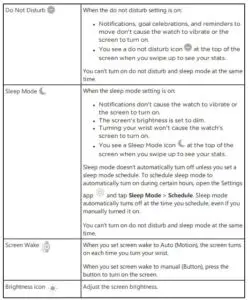
Adjust settings
Manage basic settings in the Settings app

Tap a setting to adjust it. Swipe up to see the full list of settings.
Check battery level
Swipe down from the top of the screen. Wait 2 seconds for the control center to
disappear. The battery level icon is in the top left.
If your watch’s battery is low (less than 24 hours remaining), a red battery indicator
appears on the clock face. If your watch’s battery is critically low (less than 4 hours
remaining), the battery indicator flashes.

Wi-Fi won’t work on Ionic when the battery is 25% or less, and you’ll be unable to
update your device.
Set up device lock
To help keep your watch secure, turn on device lock in the Fitbit app, which
prompts you to enter a personal 4-digit PIN code to unlock your watch. If you set
up Fitbit Pay to make contactless payments from your watch, device lock is turned
on automatically and you’re required to set a code. If you don’t use Fitbit Pay,
device lock is optional.
Turn on device lock or reset your PIN code in the Fitbit app:
From the Today tab in the Fitbit app, tap your profile picture > Ionic tile
> Device Lock.
For more information, see help.fitbit.com
Turn off the screen
To turn off Ionic’s screen when not in use, briefly cover the watch face with your
opposite hand, press the back button, or turn your wrist away from your body.
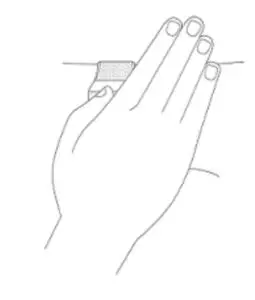
Care for Ionic
It’s important to clean and dry Ionic regularly. For more information, see
fitbit.com/productcare
Use Ionic without your phone
Key functions of the watch are designed to be used without needing your phone
nearby:
- Set an alarm
- “See your stats” on page 32
- “Track your hourly activity” on page 33
- “See your heart rate” on page 35
- “Work out with Fitbit Coach” on page 42
- “Practice guided breathing” on page 35
- “Listen to personal music and podcasts” on page 45
- “Use credit and debit cards” on page 52
After completing an activity, remember to sync Ionic with the Fitbit app to transfer
your stats to your dashboard.
Apps and Clock Faces
The Fitbit App Gallery and Clock Gallery offer apps and clock faces to personalize
your watch and meet a variety of health, fitness, timekeeping, and everyday needs.
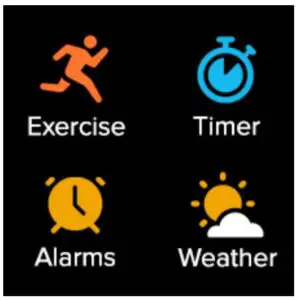
Open apps
From the clock face, swipe left to see the apps installed on your watch. To open an
app, tap it.
Organize apps
To change the placement of an app on Ionic, press and hold an app until it’s
selected, and drag it to a new location. The app is selected when its icon increases
slightly in size and the watch vibrates.
Remove apps
You can remove most apps installed on Ionic:
- From the Today tab in the Fitbit app, tap your profile picture > Ionic tile.
- Tap Apps.
- In the My Apps tab, find the app you want to remove. You may have to swipe up to find it.
- Tap the app > Remove.
Update apps
Apps update over Wi-Fi as needed. Ionic searches for updates when plugged into
the charger and in range of your Wi-Fi network.
You can also manually update apps. For more information, see help.fitbit.com
Download additional apps
- From the Today tab in the Fitbit app, tap your profile picture > Ionic tile.
- Tap Apps > All Apps.
- Browse the available apps. When you find one you want to install, tap it.
- Tap Install to add the app to Ionic.
For more information, see help.fitbit.com
Change the clock face
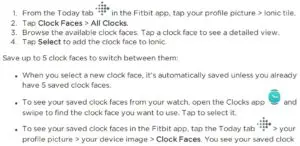
faces in My Clock Faces.
- To remove a clock face, tap the clock face > Remove Clock Face.
- To switch to a saved clock face, tap the clock face > Select.
Notifications
Ionic can show call, text, calendar, and app notifications from your phone to keep
you informed. Keep your watch within 30 feet of your phone to receive
notifications.
Set up notifications
Check that Bluetooth on your phone is on and that your phone can receive
notifications (often under Settings > Notifications). Then set up notifications:
- From the Today tab in the Fitbit app, tap your profile picture > Ionic tile.
- Tap Notifications.
- Follow the on-screen instructions to pair your watch if you haven’t already.
Call, text, and calendar notifications are turned on automatically. - To turn on notifications from apps installed on your phone, including Fitbit and WhatsApp, tap App Notifications and turn on the notifications you want to see.
Note that if you have an iPhone or iPad, Ionic shows notifications from all calendars synced to the Calendar app. If you have an Android phone, Ionic shows calendar notifications from the calendar app you choose during setup.
For more information, see help.fitbit.com
See incoming notifications
A notification causes your watch to vibrate. If you don’t read the notification when it arrives, you can check it later by swiping down from the top of the screen.

If your watch’s battery level is critically low, notifications won’t cause Ionic to
vibrate or the screen to turn on.
Manage notifications
Ionic stores up to 30 notifications, after which the oldest are replaced as you receive
new ones.
To manage notifications:
- Swipe down from the top of the screen to see your notifications and tap any
notification to expand it. - To delete a notification, tap to expand it, then swipe to the bottom and tap
Clear. - To delete all notifications at once, swipe to the top of your notifications and
tap Clear All.
Turn off notifications
Turn off certain notifications in the Fitbit app, or turn off all notifications in the quick settings on Ionic. When you turn off all notifications, your watch won’t vibrate and the screen won’t turn on when your phone receives a notification.
To turn off certain notifications:
- From the Today tab in the Fitbit app on your phone, tap your profile
picture > Ionic tile > Notifications. - Turn off the notifications you no longer want to receive on your watch.
- Sync your watch to save your changes.
To turn off all notifications:
- Swipe down from the top of the screen and tap the quick settings icon .
- Tap the Do Not Disturb icon . All notifications, including goal celebrations
and reminders to move, are turned off.
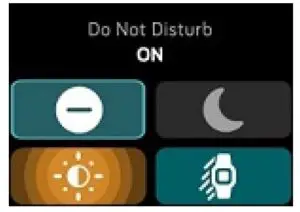
Note that if you use the do not disturb setting on your phone, you don’t receive
notifications on your watch until you turn off this setting.
Answer or reject phone calls
If paired to an iPhone or Android (8.0+) phone, Ionic lets you accept or reject
incoming phone calls. If your phone is running an older version of the Android OS,
you can reject, but not accept, calls on your watch.
To accept a call, tap the green phone icon on your watch’s screen. Note that you
can’t speak into the watch—accepting a phone call answers the call on your nearby
phone. To reject a call, tap the red phone icon to send the caller to voicemail.
The caller’s name appears if that person is in your contacts list; otherwise you see a
phone number.

Respond to messages
Respond directly to text messages and notifications from select apps on your watch
with preset quick replies. This feature is currently available on devices paired to an
Android phone. Keep your phone nearby with the Fitbit app running in the
background to respond to messages from your watch.
To respond to a message:
- Tap the notification on your watch. To see recent messages, swipe down from
the clock face. - Tap Reply. If you don’t see an option to reply to the message, replies aren’t
available for the app that sent the notification. - Choose a text reply from the list of quick replies or tap the emoji icon to
choose an emoji.
For more information, including how to customize quick replies, see help.fitbit.com
Timekeeping
Alarms vibrate to wake or alert you at a time you set. Set up to 8 alarms to occur
once or on multiple days of the week. You can also time events with the stopwatch
or set a countdown timer.
Use the Alarms app
Set one-time or recurring alarms with the Alarms app . When an alarm goes off,
your watch vibrates.
When setting an alarm, turn on Smart Wake to allow your watch to find the best
time to wake you starting 30 minutes before the alarm time you set. It avoids
waking you during deep sleep so you’re more likely to wake up feeling refreshed. If
Smart Wake can’t find the best time to wake you, your alarm alerts you at the set
time.
For more information, see help.fitbit.com
Dismiss or snooze an alarm
To dismiss the alarm, tap the check mark. To snooze the alarm for 9 minutes, tap the ZZZ icon.
Snooze the alarm as many times as you want. Ionic automatically goes into snooze
mode if you ignore the alarm for more than 1 minute.

Use the Timer app
Time events with the stopwatch or set a countdown timer with the Timer app
on your watch. You can run the stopwatch and countdown timer at the same time.
For more information, see help.fitbit.com
Activity and Sleep
Ionic continuously tracks a variety of stats whenever you wear it, including hourly
activity, heart rate, and sleep. Data automatically syncs when in range of the Fitbit
app throughout the day.
See your stats
Swipe up from the clock face on your watch to access Fitbit Today, which shows up
to 7 of these stats:
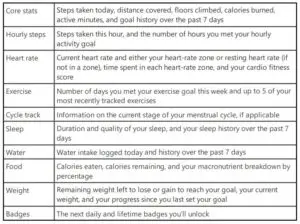
Swipe left or right on each tile to view the complete set of stats. Tap the + icon on
the water tile or weight tile to log an entry.
To reorder the tiles, press and hold a row, then drag it up or down to change its
position. Tap Settings at the bottom of the screen to choose which stats you see.
Find your complete history and other information detected by your watch in the
Fitbit app.
Track a daily activity goal
Ionic tracks your progress toward a daily activity goal of your choice. When you
reach your goal, your watch vibrates and shows a celebration.
Choose a goal
Set a goal to help you get started on your health and fitness journey. To begin, your
goal is to take 10,000 steps per day. Choose to change the number of steps, or pick
a different activity goal depending on your device.
For more information, see help.fitbit.com.
Track progress toward your goal on Ionic. For more information, see “See your
stats” on the previous page.
Track your hourly activity
Ionic helps you stay active throughout the day by keeping track of when you’re
stationary and reminding you to move.
Reminders nudge you to walk at least 250 steps each hour. You feel a vibration and
see a reminder on your screen at 10 minutes before the hour if you haven’t walked
250 steps. When you meet the 250-step goal after receiving the reminder, you feel
a second vibration and see a congratulatory message.
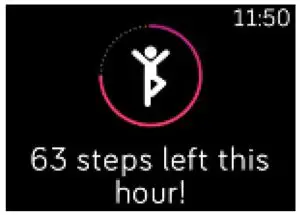
For more information, see help.fitbit.com.
Track your sleep
Wear Ionic to bed to automatically track basic stats about your sleep, including your
time asleep, sleep stages (time spent in REM, light sleep, and deep sleep), and
sleep score (the quality of your sleep).
Ionic also tracks your estimated oxygen variation throughout the night to help you uncover potential breathing disturbances. To see your sleep stats, sync your watch when you wake up and check the Fitbit app, or swipe up from the clock face on your watch to check the Sleep tile in Fitbit Today.
For more information, see help.fitbit.com
Set a sleep goal
To start, you have a sleep goal of 8 hours of sleep per night. Customize this goal to
meet your needs.
For more information, see help.fitbit.com
Learn about your sleep habits
With a Fitbit Premium subscription, see more details about your sleep score and
how you compare to your peers, which can help you build a better sleep routine
and wake up feeling refreshed.
For more information, see help.fitbit.com
See your heart rate
Ionic tracks your heart rate throughout the day. Swipe up from the clock face to see
your real-time heart rate and your resting heart rate. For more information, see “See
your stats” on page 32. Certain clock faces show your real-time heart rate on the
clock screen.
During a workout, Ionic shows your heart-rate zone to help you target the training
intensity of your choice.
For more information, see “Check your heart rate”.
Practice guided breathing
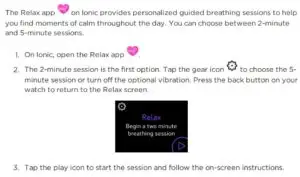
![]()
After the exercise, a summary appears that shows your alignment (how closely you
followed the breathing prompt), your heart rate at the start and end of the session,
and how many days you completed a guided breathing session this week.
All notifications are automatically disabled during the session.
For more information, see help.fitbit.com
Fitness and Exercise
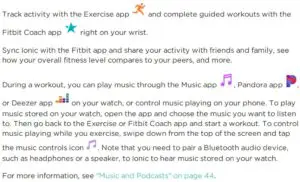
Track your exercise automatically
Ionic automatically recognizes and records many high-movement activities which
are at least 15 minutes long. Sync your device to see basic stats about your activity
in the Exercise tile in the Fitbit app.
For more information, including how to change the minimum duration before an
activity is tracked, see help.fitbit.com
Track and analyze exercise with the Exercise app
Track specific exercises with the Exercise app on Ionic to see real-time stats,
including heart-rate data, calories burned, elapsed time, and a post-workout
summary on your wrist. For complete workout stats, and a workout intensity map if
you used GPS, tap the Exercise tile in the Fitbit app.
Track an exercise
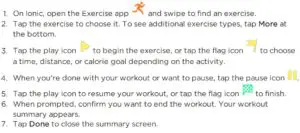
Notes:
- Ionic shows 3 real-time stats. Swipe the middle stat to see all of your real-time
stats. - If you set an exercise goal, your watch vibrates and flashes when you’re
halfway to your goal and when you reach the goal. - If the exercise uses GPS, an icon appears in the top left as your watch connects
to a GPS signal. When the screen says “connected” and Ionic vibrates, GPS is
connected.
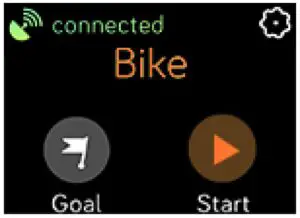
Customize your exercise settings and shortcuts
Customize various settings for each exercise type on your watch. Settings include:
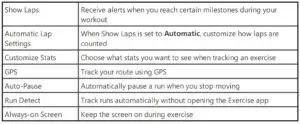
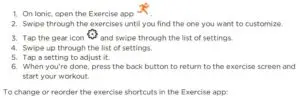

Check your workout summary
After you complete a workout, Ionic shows a summary of your stats.
Sync your watch, and tap the Exercise tile in the Fitbit app to see additional stats
and a workout intensity map if you used GPS.
Check your heart rate
Heart-rate zones help you target the training intensity of your choice. See your
current zone and progress toward your maximum heart rate on your device next to
your heart-rate reading. In the Fitbit app, you can see your time spent in zones
during a particular day or exercise. Three zones based on American Heart
Association recommendations are available, or you can create a custom zone if you
have a specific heart rate you’re targeting.
Default heart-rate zones
Default heart-rate zones are calculated using your estimated maximum heart rate.
Fitbit calculates your maximum heart rate with the common formula of 220 minus
your age.
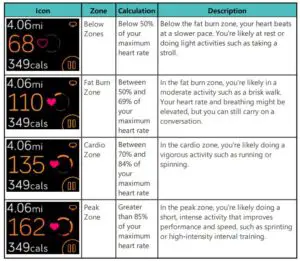
Note that the heart-rate value appears gray if your watch is searching for a stronger
reading.
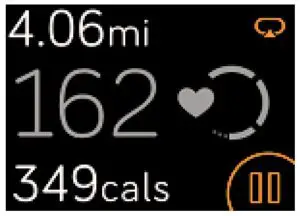
Custom heart-rate zones
Instead of using these 3 heart-rate zones, you can create a custom zone to target a
specific heart-rate range in the Fitbit app.
For more information, see help.fitbit.com
Work out with Fitbit Coach
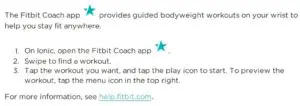
Share your activity
After you complete a workout, sync your watch with the Fitbit app to share your
stats with friends and family.
For more information, see help.fitbit.com
View your cardio fitness score
View your overall cardiovascular fitness on your wrist or in the Fitbit app. See your
cardio fitness score and cardio fitness level, which shows how you compare to your
peers.
On your watch, swipe up to Fitbit Today and find the heart-rate tile. Swipe left to
see your time spent in each heart-rate zone for the day. Swipe left again to see your
cardio fitness score and cardio fitness level.
For more information, see help.fitbit.com
Music and Podcasts
Store your favorite playlists on Ionic, and listen to music and podcasts with
Bluetooth headphones or speakers without needing your phone.
Connect Bluetooth headphones or speakers
Connect up to 8 Bluetooth audio devices to listen to playlists on your watch. When
you add a new Bluetooth device, make sure both the device and Ionic are in pairing
mode.
To pair a new Bluetooth audio device:
- Start by activating pairing mode on your Bluetooth headphones or speaker.
- On Ionic, open the Settings app > Bluetooth.
- Tap + Audio Device. Ionic searches for nearby devices.
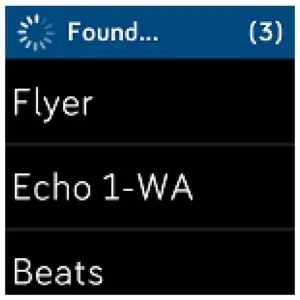
- When Ionic finds nearby Bluetooth audio devices, it shows a list on the screen.
Tap the name of the device you want to pair.
When pairing is complete, a check mark appears on the screen.
To listen to music with a different Bluetooth device:
- On Ionic, open the Settings app > Bluetooth.
- Tap the device you want to use, or pair a new device. Then wait a moment for
the device to connect.
For more information, see help.fitbit.com
Listen to personal music and podcasts
With the Music app on Ionic, you can store several hours worth of your favorite
songs and podcasts to play right from your wrist. To download playlists to your
watch, you need a computer that can connect to the same Wi-Fi connection as your
watch, and the free Fitbit Connect app.
Keep in mind you can only transfer files that you own or that don’t require a license. Songs from music subscription services are not supported for download to the Music app. For information on supported
subscription services, see “Use Deezer on Ionic” on page 51 and “Use Pandora on
Ionic (United States only)” on page 50.
For instructions, see help.fitbit.com
Add music and podcasts with your Windows 10 PC
Download playlists of your personal music and podcasts from your iTunes Library or Windows Media Player to Ionic. Note that you can also create playlists in the Fitbit desktop app using the drag-and-drop feature to add your tracks.
Create a playlist
Create at least 1 playlist of songs or podcasts to download to your watch.
If you use iTunes, make sure you approve the app to share your playlists with your watch:
Open iTunes on your computer > Edit > Preferences > Advanced > Share iTunes
Library XML with other applications > OK.
Install the Fitbit app
If you haven’t already done so, install the Fitbit app on your computer:
- Click the Start button on your PC and open the Microsoft Store.
- Search for “Fitbit app.” When you find it, click Free to download the app.
- Click Microsoft account to sign in with your existing Microsoft account. If you
don’t already have an account with Microsoft, follow the on-screen instructions to create a new account. - When the app is installed, open it and log in to your Fitbit account.
Connect to Wi-Fi
Make sure Ionic and your PC are able to connect to the same Wi-Fi network:
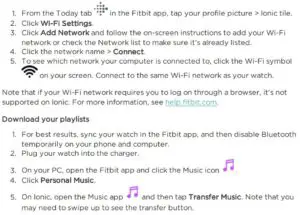
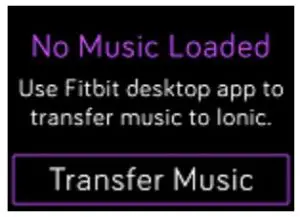
- Wait a few moments for Ionic to connect. Note it can sometimes take a minute or two to connect.
- When prompted, follow the on-screen instructions on your computer to
choose the playlists you want to download to your watch. After you choose a
playlist, the download starts automatically. - Note that if you take several minutes to pick your first playlist, Wi-Fi may
disconnect to preserve your battery. Tap the Transfer Music button again to
reconnect and continue choosing your playlists. - After the download is complete, pair Bluetooth headphones or a speaker to
Ionic and open the Music app to listen to your playlists. Your phone and
computer don’t need to be nearby in order to listen to music from the Music
app.
For more information, see help.fitbit.com
Add music and podcasts with your Mac
Download playlists of your personal music and podcasts from your iTunes Library to Ionic.
Create a playlist
Within iTunes, create at least 1 playlist of songs or podcasts to download to your
watch.
Make sure you approve the iTunes app to share your playlists with your watch:
Open iTunes on your computer > Edit > Preferences > Advanced > Share iTunes Library XML with other applications > OK.
Connect to Wi-Fi
Make sure Ionic and your Mac are able to connect to the same Wi-Fi network:
- From the Today tab in the Fitbit app, tap your profile picture > Ionic tile.
- Tap Wi-Fi Settings
- Tap Add Network and follow the on-screen instructions to add your Wi-Fi
network or check the Network list to make sure it’s already listed. - Tap the network name > Connect.
- To see which network your computer is connected to, click the Wi-Fi symbol
on your screen. Connect to the same Wi-Fi network as your watch.
Note that if your Wi-Fi network requires you to log on through a browser, it’s not
supported on Ionic. For more information, see help.fitbit.com
Install Fitbit Connect
Install a free software application called Fitbit Connect that lets you download
music from your iTunes Library to Ionic.
- On your Mac, go to fitbit.com/setup
- Scroll down and click the option to Download for Mac.
- Double-click Install Fitbit Connect.pkg. The Fitbit Connect installer opens.
- Click Continue to move through the installer.
Download your playlists
- For best results, sync your watch in the Fitbit app, and then disable Bluetooth
temporarily on your phone and computer. - Plug your watch into the charger.
- In the Fitbit Connect window on your computer, click Manage My Music.
- Log in to your Fitbit account.
- On Ionic, open the Music app and then tap Transfer Music. Note that you
may need to swipe up to see the transfer button.

- Wait a few moments for Ionic to connect via Wi-Fi. Note this can sometimes
take a minute or two. - When prompted, follow the on-screen instructions to choose the playlists you
want to download to Ionic. After you choose a playlist, the download starts
automatically. - Note that if you take several minutes to pick your first playlist, Wi-Fi may
disconnect to preserve your battery. Tap the Transfer Music button again to
reconnect and continue choosing your playlists. - After the download is complete, pair Bluetooth headphones or a speaker to
Ionic and open the Music app to listen to your playlists. Your phone and
computer don’t need to be nearby in order to listen to music from the Music
app.
For more information, see help.fitbit.com
Control music with Ionic
Control music and podcasts playing on Ionic or on your phone.
Choose the music source
- Swipe down from the top of your screen, and tap the music controls icon .
- Tap the 3 dots icon.
- Tap the phone or watch icon to switch the source.
If you have an Android or Windows 10 phone, turn on Bluetooth Classic to control
music on your phone:
- Open the Settings app on Ionic > Bluetooth > Restore Music Controls.
- On your phone, navigate to the Bluetooth settings where paired devices are
listed. Your phone will scan for available devices. - Tap Ionic (Classic).
Control music
- While music is playing, swipe down from the top of your screen and tap the
music controls icon . - Play, pause, or tap the arrow icons to skip to the next track or previous track (if the audio source permits it). Tap the + and – icons to control the volume.

Use Pandora on Ionic (United States only)
With the Pandora app for Ionic, download up to 3 of your most-played Pandora
stations or popular curated Workout stations directly to your watch. Note that you
need a paid subscription to Pandora and a Wi-Fi connection to download stations.
For more information about Pandora subscriptions, see help.pandora.com
For instructions, see help.fitbit.com
Use Deezer on Ionic
With the Deezer app for Ionic, download your Deezer playlists and Flow
directly to your watch. Note that you need a paid subscription to Deezer and a Wi-
Fi connection to download music. For more information about Deezer subscriptions, see support.deezer.com
For instructions, see help.fitbit.com
Fitbit Pay
Ionic includes a built-in NFC chip, which lets you use your credit and debit cards on your watch.
Use credit and debit cards
Set up Fitbit Pay in the Wallet section of the Fitbit app, and use your watch to make
purchases in stores that accept contactless payments.
We’re always adding new locations and card issuers to our list of partners. To see if
your payment card works with Fitbit Pay, see fitbit.com/fitbit-pay/banks
Set up Fitbit Pay
To use Fitbit Pay, add at least 1 credit or debit card from a participating bank to the
Wallet section of the Fitbit app. The Wallet is where you add and remove payment
cards, set a default card for your watch, edit a payment method, and review recent
purchases.
- From the Today tab in the Fitbit app, tap your profile picture > Ionic tile.
- Tap the Wallet tile.
- Follow the on-screen instructions to add a payment card. In some cases, your
bank might require additional verification. If you’re adding a card for the first
time, you might be prompted to set a 4-digit PIN code for your watch. Note
that you also need passcode protection enabled for your phone. - After you add a card, follow the on-screen instructions to turn on notifications
for your phone (if you haven’t already done so) to complete the setup.
You can add up to 6 payment cards to the Wallet and choose which card to set as
the default payment option on your watch.
Make purchases
Make purchases using Fitbit Pay at any store that accepts contactless payments. To
determine if the store accepts Fitbit Pay, look for the symbol below on the payment
terminal:

All customers except those in Australia:
- Activate Fitbit Pay.
- If you chose Fitbit Pay as your button shortcut, hold the back button on
your watch for 2 seconds. - Swipe down from the top of the screen and tap the Fitbit Pay icon if
you chose a different button shortcut. - If prompted, enter your 4-digit watch PIN code. Your default card appears on
the screen.

- To pay with your default card, hold your wrist near the payment terminal. To
pay with a different card, swipe to find the card you want to use, and hold
your wrist near the payment terminal.
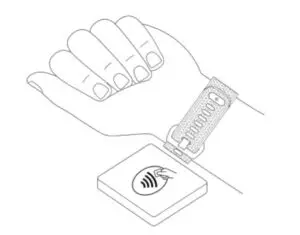
Customers in Australia:
- If you have a credit or debit card from an Australian bank, hold your watch
near the payment terminal to pay. If your card is from a bank outside of
Australia, or if you wish to pay with a card that is not your default card,
complete steps 1-3 in the section above. - If prompted, enter your 4-digit watch PIN code.
- If the purchase amount exceeds $100 AU, follow the instructions on the
payment terminal. If prompted for a PIN code, enter the PIN code for your
card (not your watch).
When the payment succeeds, your watch vibrates and you see a confirmation on
the screen.
If the payment terminal doesn’t recognize Fitbit Pay, make sure the watch face is
near the reader and that the cashier knows you’re using a contactless payment.
For added security, you must wear Ionic on your wrist to use Fitbit Pay.
For more information, see help.fitbit.com
Change your default card
- From the Today tab in the Fitbit app, tap your profile picture > Ionic tile.
- Tap the Wallet tile.
- Find the card you want to set as the default option.
- Tap Set as Default on Ionic.
Pay for transit
Use Fitbit Pay to tap on and off at transit readers that accept contactless credit or
debit card payments. To pay with your watch, follow the steps listed in “Use credit
and debit cards”.
Pay with the same card on your Fitbit watch when you tap the transit reader at the
start and end of your trip. Make sure your device is charged before beginning your
trip.
Weather
See the weather in your current location, as well as 2 additional locations you
choose in the Weather app on your watch.
Check the weather
Open the Weather app to see conditions in your current location. Swipe left to view
the weather in other locations you added.
If the weather for your current location doesn’t appear, check that you turned on
location services for the Fitbit app. If you change locations or don’t see updated
data for your current location, sync your watch to see your new location and latest
data in the Weather app.
Choose your unit of temperature in the Fitbit app. For more information, see
help.fitbit.com
Add or remove a city
- From the Today tab in the Fitbit app, tap your profile picture > Ionic tile.
- Tap Apps.
- Tap the gear icon next to Weather. You may need to swipe up to find the
app. - Tap Add city to add up to 2 additional locations or tap Edit > the X icon to
delete a location. Note that you can’t delete your current location. - Sync your watch with the Fitbit app to see the updated locations on your
watch.
Update, Restart, and Erase
Some troubleshooting steps may require you to restart your watch, while erasing it
is useful if you want to give Ionic to another person. Update your watch to receive
new Fitbit OS updates.
Restart Ionic
To restart your watch, press and hold the back and bottom buttons for a few
seconds until you see the Fitbit logo on the screen.
Ionic has a small hole (altimeter sensor) on the back of the device. Don’t attempt to
restart your device by inserting any items, such as paper clips, into this hole as you
can damage your watch.
Erase Ionic
If you want to give Ionic to another person or wish to return it, first clear your
personal data:
On Ionic, open the Settings app > About > Factory Reset.
Update Ionic
Update your watch to get the latest feature enhancements and product updates.
When an update is ready to install, a notification appears in the Fitbit app. After you start the update, a progress bar appears on Ionic and in the Fitbit app as the update downloads, and then installs. Keep your watch and phone close to each other during the update.
For best results, make sure your watch is charged and can connect to your Wi-Fi
network.
Note: Updating Ionic may be demanding on the battery. We recommend plugging
your watch into the charger before starting an update.
For more information, see help.fitbit.com
Troubleshooting
If Ionic isn’t working properly, see our troubleshooting steps below. Visit
help.fitbit.com for more information.
Heart-rate signal missing
Ionic continuously tracks your heart rate while you’re exercising and throughout the
day. If the heart-rate sensor on your watch has difficulty detecting a signal, dashed
lines appear.

If your watch doesn’t detect a heart-rate signal, first make sure heart-rate tracking is
turned on in the Settings app on your watch. Next, make sure you’re wearing your
watch correctly, either by moving it higher or lower on your wrist or by tightening
or loosening the band. Ionic should be in contact with your skin. After holding your arm still and straight for a short time, you should see your heart rate again.
For more information, see help.fitbit.com
GPS signal missing
Environmental factors including tall buildings, dense forest, steep hills, and even
thick cloud cover can interfere with your watch’s ability to connect to GPS satellites. If your watch is searching for a GPS signal during an exercise, you’ll see
“connecting” appear at the top of the screen. If Ionic can’t connect to a GPS satellite after 10 minutes, the tracker stops trying to connect until the next time you start a GPS exercise.
For best results, wait for Ionic to find the signal before you start your workout.
Can’t connect to Wi-Fi
If Ionic can’t connect to Wi-Fi, you might have entered an incorrect password, or
the password might have changed:
- From the Today tab in the Fitbit app, tap your profile picture > Ionic tile.
- Tap Wi-Fi Settings > Next.
- Tap the network you want to use > Remove.
- Tap Add Network and follow the on-screen instructions to reconnect the Wi-
Fi network.
To check if your Wi-Fi network is working correctly, connect another device to your network; if it connects successfully, try again to connect your watch.
If Ionic still won’t connect to Wi-Fi, make sure that you’re attempting to connect
your watch to a compatible network. For best results, use your home Wi-Fi
network. Ionic can’t connect to 5GHz Wi-Fi, WPA enterprise, or public networks
that require logins, subscriptions, or profiles. For a list of compatible network types,
see “Connect to Wi-Fi”.
After you verify the network is compatible, restart your watch and try connecting
to Wi-Fi again. If you see other networks appear in the list of available networks, but not your preferred network, move your watch closer to your router.
If you’re trying to download personal music or podcasts, make sure Ionic and your
computer are connected to the same Wi-Fi network. For a stronger Wi-Fi
connection, keep your watch close to your router.
For more information, see help.fitbit.com
Other issues
If you experience any of the following issues, restart your watch:
- Won’t sync
- Won’t respond to taps, swipes, or button press
- Won’t track steps or other data
For instructions, see “Restart Ionic” on page 57.
For more information or to contact Customer Support, see help.fitbit.com
General Info and Specifications
Sensors
Fitbit Ionic contains the following sensors and motors:
- A MEMS 3-axis accelerometer, which tracks motion patterns
- An altimeter, which tracks altitude changes
- A GPS receiver with GLONASS, which tracks your location during a workout
- An optical heart-rate tracker
- An ambient light sensor
- A vibration motor
Materials
The housing and buckle on Ionic are made of anodized aluminum. While anodized
aluminum can contain traces of nickel, which can cause an allergic reaction in
someone with nickel sensitivity, the amount of nickel in all Fitbit products meets the European Union’s stringent Nickel Directive.
The band that comes with Ionic is made of a flexible, durable elastomer material
similar to that used in many sports watches. It doesn’t contain latex. Accessory
wristbands are available in genuine leather.
Wireless technology
Ionic contains a Bluetooth 4.0 radio receiver, Wi-Fi chip, and NFC chip.
Haptic feedback
Ionic contains a vibration motor for alarms, goals, notifications, reminders, and apps.
Battery
Ionic contains a rechargeable lithium-polymer battery.
Memory
Ionic stores your data, including daily stats, sleep information, and exercise history,
for 7 days. Sync your watch with the Fitbit app to access your historical data.
Display
Ionic has a color LCD display.
Band size
Band sizes are shown below. Note that accessory bands sold separately may vary
slightly.

Environmental conditions
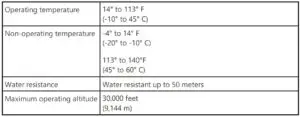
Learn more
To learn more about your watch, how to track your progress in the Fitbit app, and
how to build healthy habits with Fitbit Premium, visit help.fitbit.com
Return policy and warranty
Find warranty information and the fitbit.com return policy on our website.
Regulatory and Safety Notices
Model Name: FB503
Notice to the User: Regulatory content for certain regions can also be viewed on
your device. To view the content:
Settings > About > Regulatory Info
USA: Federal Communications Commission (FCC) statement
FCC ID: XRAFB503
Notice to the User: The FCC ID can also be viewed on your device. To view the
content:
Settings > About > Regulatory Info
This device complies with Part 15 of the FCC Rules.
Operation is subject to the following two conditions:
- This device may not cause harmful interference and
- This device must accept any interference, including interference that may
cause undesired operation of the device.
FCC Warning
Changes or modifications not expressly approved by the party responsible for
compliance could void the user’s authority to operate the equipment.
Note: This equipment has been tested and found to comply with the limits for a
Class B digital device, pursuant to part 15 of the FCC Rules. These limits are
designed to provide reasonable protection against harmful interference in a
residential installation.
This equipment generates, uses and can radiate radio frequency energy and, if not installed and used in accordance with the instructions, may cause harmful interference to radio communications.
However, there is no guarantee that interference will not occur in a particular installation. If this equipment does cause harmful interference to radio or television reception, which can be determined by turning the equipment off and on, the user is encouraged to try to correct the interference by one or more of the following measures:
- Reorient or relocate the receiving antenna.
- Increase the separation between the equipment and receiver.
- Connect the equipment into an outlet on a circuit different from that to which
the receiver is connected. - Consult the dealer or an experienced radio/TV technician for help.
This device meets the FCC and IC requirements for RF exposure in public or
uncontrolled environments.
Canada: Industry Canada (IC) statement
IC: 8542A-FB503
Notice to the User: The IC ID can also be viewed on your device. To view the
content:
Settings > About > Regulatory Info
This device meets the IC requirements for RF exposure in public or uncontrolled
environments.
IC Notice to Users English/French in accordance with current issue of RSS GEN:
This device complies with Industry Canada license exempt RSS standard(s).
Operation is subject to the following two conditions:
- This device may not cause interference, and
- This device must accept any interference, including interference that may
cause undesired operation of the device.
European Union (EU)
Simplified EU Declaration of Conformity
Hereby, Fitbit, Inc. declares that the radio equipment type Model FB503 is in
compliance with Directive 2014/53/EU. The full text of the EU declaration of
conformity is available at the following internet address: www.fitbit.com/safety
Safety Statement
This equipment has been tested to comply with safety certification in accordance
with the specifications of EN Standard: EN60950-1:2006 + A11:2009 + A1:2010 +
A12:2011 + A2:2013 & EN62368-1:2014 + A11:2017.
Frequency Information
Frequency range (MHz): 2400-2483.5
©2020 Fitbit, Inc. All rights reserved. Fitbit and the Fitbit logo are trademarks
or registered trademarks of Fitbit in the US and other countries. A more
complete list of Fitbit trademarks can be found at
https://uspto.report/company/Fitbit-Inc. Third-party trademarks
mentioned are the property of their respective owners.
